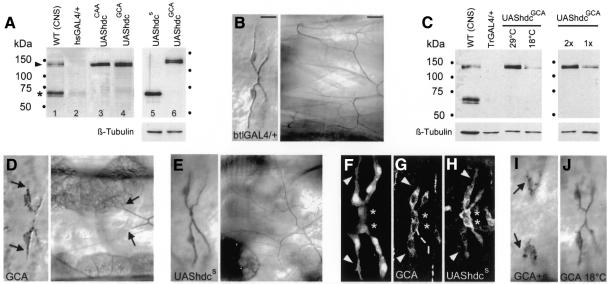Fig. 1. The Hdc readthrough protein is a dose-dependent branching inhibitor. (A and C) Western blot of salivary gland extracts probed with the Hdc monoclonal antibody that recognizes both termination (asterisk) and readthrough (arrowhead) products. In both blots CNS extracts serve as wild-type controls (lane 1). (A) In larvae of the hsGAL4 driver strain a small amount of endogenous product is detected (lane 2) in salivary glands. The UAShdcCAA (lane 3) and the UAShdcGCA constructs produce only the long product (lanes 4 and 6) whereas theUAShdcs generates only the short protein under the control of the same driver (lane 5). Long and short proteins are produced at similar levels as shown by the tubulin loading control in lanes 5 and 6. (C) The amount of HdcGCA is higher at 29°C compared with 18°C due to the increased activity of the GAL4 driver similarly protein levels are higher in strains carrying two copies of the UAShdcGCA (2×) compared with one (1×). Tubulin was used as a loading control. (B, D–J) Dorsal view (anterior to the left) showing the tracheal dorsal branches in late stage 16 embryos (B–E, left panels and F–J) and in third instar larvae (B–E, right panels). (B, D, E, I and J) Embryos were stained to visualize tracheal lumen and terminal cells, in (G and H) with Hdc monoclonal antibody to visualize cell extensions and Hdc protein produced by the transgenes activated by the BtlGAL4 driver. Asterisks in (F), (G) and (H) indicate the fusion cells, where endogenous hdc is normally expressed. In (F), 1-eve-1 embryos were stained for β-galactosidase showing wild-type terminal cell extensions. Ectopic pan-tracheal expression of UAShdcGCA, producing the long Hdc protein, severely reduced terminal lumen (arrows in D), cellular extensions (arrowheads in G) and formation of tracheoles in larvae (arrows in D) compared to controls (B and arrowheads in F). Ectopic tracheal expression of UAShdcs, producing the short Hdc protein (lane 5 in A), caused less reduction in lumen length (E) and cell extension in embryos (H) and no inhibition of tracheoles in larvae (E). Ectopic tracheal coexpression of the two constructs (I) enhanced suppression of lumen extensions (arrows in I). The effect of UAShdcGCA on terminal lumen extension is milder at 18°C (J) compared to its effect at 29°C. Bars in (B) correspond to 10 µm for embryos and 50 µm for larvae.

An official website of the United States government
Here's how you know
Official websites use .gov
A
.gov website belongs to an official
government organization in the United States.
Secure .gov websites use HTTPS
A lock (
) or https:// means you've safely
connected to the .gov website. Share sensitive
information only on official, secure websites.
